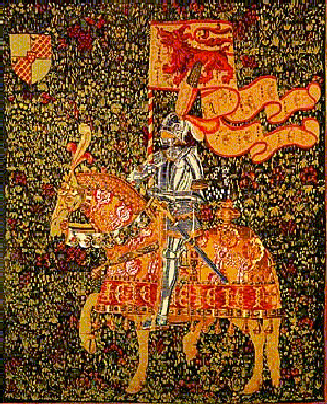

![]()
Today when asked about tapestries, most will imagine glorious wall decorations, with fantastic scenes and vibrant colors hanging on museum walls. In the Middle Ages however, tapestries were not only used as wall hangings, but because of their warm and durable fabric, as covers for beds tables, and furniture.
Although wealthy burghers could afford to purchase several tapestries, the medieval tapestry industry was mostly supported by nobles who owned several houses. Since the interiors of these houses were minimally furnished when the owner was away, there was a need for something quick and easy to transform the barren house into a home when the owner came there. Tapestries provided the perfect solution, since they were easy to move, store and gave any room an instant makeover.
Some tapestries were made to
order by requests; the majority, however, were woven after existing designs. The tapestry
shown above was ordered from Wuillaume Desreumaulx of Tournai by Jean de Daillon, seigneur
de Lude. He, however, never got to see it, because he died in 1481 and the tapestry was
delivered to his widow in 1483. This piece is the only one known to have survived from a
series of wall hangings it belonged to. In the tapestry a mounted knight can be seen, with
arms of Jean de Daillon. The colors are bright and vibrant perhaps symbolizing the
knight's strength and victory in battle.
To learn about different aspects of a
knight's life, you can click on various parts of the tapestry above.
A Timeless History of Tapestry and Wall Hangings
![]()
Knighthood - Although the concept of knighthood existed before the eleventh century, it wasn't until the Norman Conquest, which occurred in 1066, that being a knight become a profession. William the Conqueror organized his cavalry into a group of knights, and as a result a knight's services, majority of which included fighting battles, became an essential part of life in the Middle Ages. Despite the popular belief, however, a knight's duties went beyond the battlefield. During periods of peace he was heavily involved in keeping his county in order. Each knight had assigned judicial duties, which included jury duty, and inspection of grounds in cases of land disputes and dowry agreements. In criminal cases a knight became both the coroner and a detective. He was responsible for inspecting the crime scene and the victim, making notes and taking precise measurements of the wounds, about which he later testified in court. Although these duties gave knight's some power, bad performance in assignments could result in punishment.
![]()
Horse - One of the most prized possessions of a knight, horses were not only used for riding and carrying of heavy objects; they were often a knight's only companion on long journeys. Different types of horses were used on different occasions. The destrier, a powerful war-horse was used for its strength, to carry a knight's armor to and from battles and tournaments. The palfrey was a knight's usual horse, used when he wasn't at war, and a courser was used when hunting. Horses were quite expensive for a knight to buy and maintain; therefore if a knight's horse was lost in battle, his lord was expected to replace it.
![]()
Sword - A knight's most prized possession, a sword served as a knight's favorite weapon and a symbol of honor and authority, as the blade and the hilt formed the sacred sign of the cross. Usually 30 inches long, this two-edged weapon, capable of delivering deadly blows, weighed only three to four pounds, making it easy for the knight to carry in battle. A sword could be obtained in several different ways. It could be bought from a traveler coming from a weapon-making town, obtained in the battlefield or a tournament, or gotten as a gift from a lord. Excalibur Arthur's great sword, also called Caliburnis by Geoffrey of Monmouth, is said to be the same as the Sword in the Stone in some literary works. In others, however, it is given (and later taken from) Arthur by the Lady of the Lake.
![]()
Heraldry - The engraving of a shield or a breastplate with distinct and different objects, thereby setting a knight apart is referred to as heraldry. The tradition of heraldry originated in the 12th century with the introduction of a new helmet, which hid the face of its wearer, leaving him unrecognizable. This custom however became more then just a means of recognition, as it also came to serve as a symbol of status, passed down from generation to generation. These emblems were put on banners, horses, and surcoats covering the knight's armor, making it customary to call them "coats-of-arms". King Arthur's heraldry includes an image of the Virgin Mary, as well as three or thirteen crowns. The three crowns were probably used to indicate Arthur's greatness and superiority over other kings, but they later came to represent his three realms of North Wales, South Wales, and Logres. This number was then increased to thirteen to represent all the kingdoms that Arthur acquired.
![]()
Banner - a small flag carried at the end of a spear by a knight, baron, or a king, a banner served as a signal in battle. Troops continued to fight as long as their leader's banner flew, making it necessary for this symbol of success or defeat to be protected by ten knights. The banner was also used as a rallying point for troops, and served as a sign of authority for issued orders, ensuring that the battle ended in victory.
![]()
To learn even more about knightood and chivalry visit the following site:
Wyrme's Encyclopedia of Knighthood